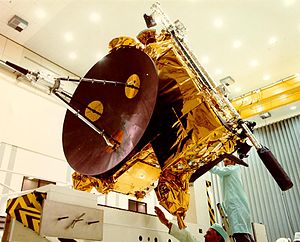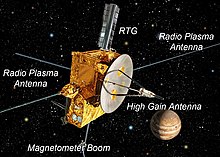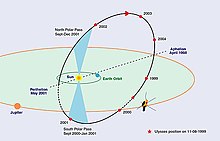Ulysses (probe)
| Ulysses (probe) | |||||||||||||||||||||||||
|---|---|---|---|---|---|---|---|---|---|---|---|---|---|---|---|---|---|---|---|---|---|---|---|---|---|
 Ulysses during the assembly |
|||||||||||||||||||||||||
| NSSDC ID | 1990-090B | ||||||||||||||||||||||||
| Mission goal | Sun | ||||||||||||||||||||||||
| Client |
|
||||||||||||||||||||||||
| Launcher | STS-41 with IUS / PAM-S | ||||||||||||||||||||||||
| construction | |||||||||||||||||||||||||
| Takeoff mass | 370 kg | ||||||||||||||||||||||||
| Course of the mission | |||||||||||||||||||||||||
| Start date | October 6, 1990, 11:47 UTC | ||||||||||||||||||||||||
| End date | June 29, 2009 | ||||||||||||||||||||||||
|
|||||||||||||||||||||||||
Ulysses [ julɪsəs ] was a spacecraft of the European Space Agency ESA and the US air and space agency NASA to study the sun . The main contractor for the probe was the German Dornier-System GmbH , which today belongs to Airbus Defense and Space . The probe was in operation from October 1990 to June 29, 2009.
history
Originally, a US and a European probe under the working title International Solar Polar Mission (ISPM) had been planned for the simultaneous investigation of the north and south poles of the sun. However, due to budget cuts, the NASA probe was canceled in 1981. That is why the Europeans made half of the payload on the Ulysses available to NASA - in return, NASA took care of the launch on a space shuttle , the radionuclide battery and the mission monitoring by JPL with the Deep Space Network . Therefore, Ulysses is to be seen primarily as a European mission - the Americans were only "brought on board" afterwards.
The launch was scheduled for May 1986 with the STS-61-F mission on a Centaur upper stage, but due to the crash of the Challenger space shuttle on January 28, 1986, the launch finally slipped to October 6, 1990 and was then with the STS mission -41 performed on an IUS / PAM-S high school combination.
Ulysses was exposed to Jupiter at 15.4 km / s . This high escape speed was necessary because Ulysses had to cut Jupiter's orbit at a relatively large angle so that it could be deflected by Jupiter into a polar solar orbit with a fly-by maneuver . With that it left the earth at the second highest speed ever reached by a space probe. (The New Horizons space probe holds the current record at 16.21 km / s.)
Around 14 years after the end of the five-year primary mission, the Ulysses mission was officially ended on June 29, 2009 due to insufficient on-board energy and the only very limited data transfers were discontinued. The probe continues to orbit the sun.
Origin of name

Ulysses is named after the English word for the Greek legendary hero Odysseus . The name is also identical to the novel Ulysses by the Irish writer James Joyce .
course
- October 6, 1990
- The probe will be launched on board the space shuttle Discovery (Mission STS-41 ).
- February 8, 1992
- The flyby on Jupiter made at a distance of 450,000 kilometers . The probe is thrown out of the ecliptic plane and enters a polar solar orbit.
- 1992 to 1998
- The probe makes its first orbit around the sun. Ulysses explored the south pole of the sun in 1994, the north pole in 1995. The closest solar approach ( perihelion ) was 1.35 AU (around 200 million kilometers).
- 1998 to 2003
- After passing Jupiter's orbit (without planets approaching), the second orbit around the sun begins with the closest approach to the south solar pole in the years 2000–2001 and to the north pole in 2001.
- 2003
- Ulysses passes Jupiter's orbit again (again without approaching the planet ) and begins a third orbit. The mission continues.
- February 2004
- Funding for the mission will be extended to March 2008.
- November 2007
- The mission will be extended for another year to March 2009.
- February 2008
- The mission is coming to an end due to a lack of energy as the fuel lines need to be heated. At 2 ° C which freezes hydrazine . The problem is circumvented by firing the engines every two hours, which, however, reduces the fuel supply.
- June 12, 2008
- ESA and NASA announce that the Ulysses mission should end on July 1, 2008.
- August 6, 2008
- The mission will continue for the time being as the hydrazine has not yet frozen.
- March 13, 2009
- Ulysses still has hydrazine left. At this point the probe can even send again at 1024 bps.
- June 29, 2009
- Shutdown of the probe, end of the mission.
Results
The scientific mission of Ulysses included, among other things, the solar corona , the solar wind , the solar magnetic field , solar plasma waves , cosmic rays, as well as numerous measurements during Jupiter's flyby in 1992. Ulysses was the first probe that flew out of the planetary plane over the poles of the sun and there Measured magnetic fields and the solar wind as a function of solar height and latitude - thanks to their unexpectedly long service life, both in the phase of low and high solar activity.
Technical specifications
- Size: 3.2m × 3.3m × 2.1m
- Mass: 366.7 kg; of which 55.1 kg of scientific equipment and 33.5 kg of fuel
- Energy source: Thermoelectric radioisotope generator (RTG)
- Equipment: Measuring devices for the investigation of solar wind, magnetic field, particle radiation, radio, X-ray and gamma radiation
- Propulsion and control: transport to earth orbit by space shuttle ; IUS - PAM-S rocket combination for launch from orbit; Maneuvering thrusters with hydrazine as fuel
- Data transmission: communication systems and antennas in X-band (60 watts) and S-band
See also
Web links
- Bernd Leitenberger: Ulysses
- NASA's Jet Propulsion Laboratory Ulysses website
- Ulysses mission overview of the ESA (English)
- ESA's Ulysses website
- Ulysses on ESA's Science and Technology website
- ESA press release on the upcoming end of the mission , February 22, 2008
Individual evidence
- ^ B. Stanek: Raumfahrt Lexikon , Halwag Verlag, Bern (1983), ISBN 3-444-10288-7, page: 306/307
- ↑ a b Ulysses Hears the Siren's Song. Jet Propulsion Laboratory , June 26, 2009, accessed June 30, 2009 .
- ↑ Sun to set on Ulysses solar mission on July 1 . ESA, June 12, 2008.
- ↑ Ulysses Status Reports
- ↑ Ulysses is still not dead . Raumfahrer.net, March 14, 2009
- ^ Joint ESA / NASA Ulysses mission to end . ESA, June 25, 2009.





